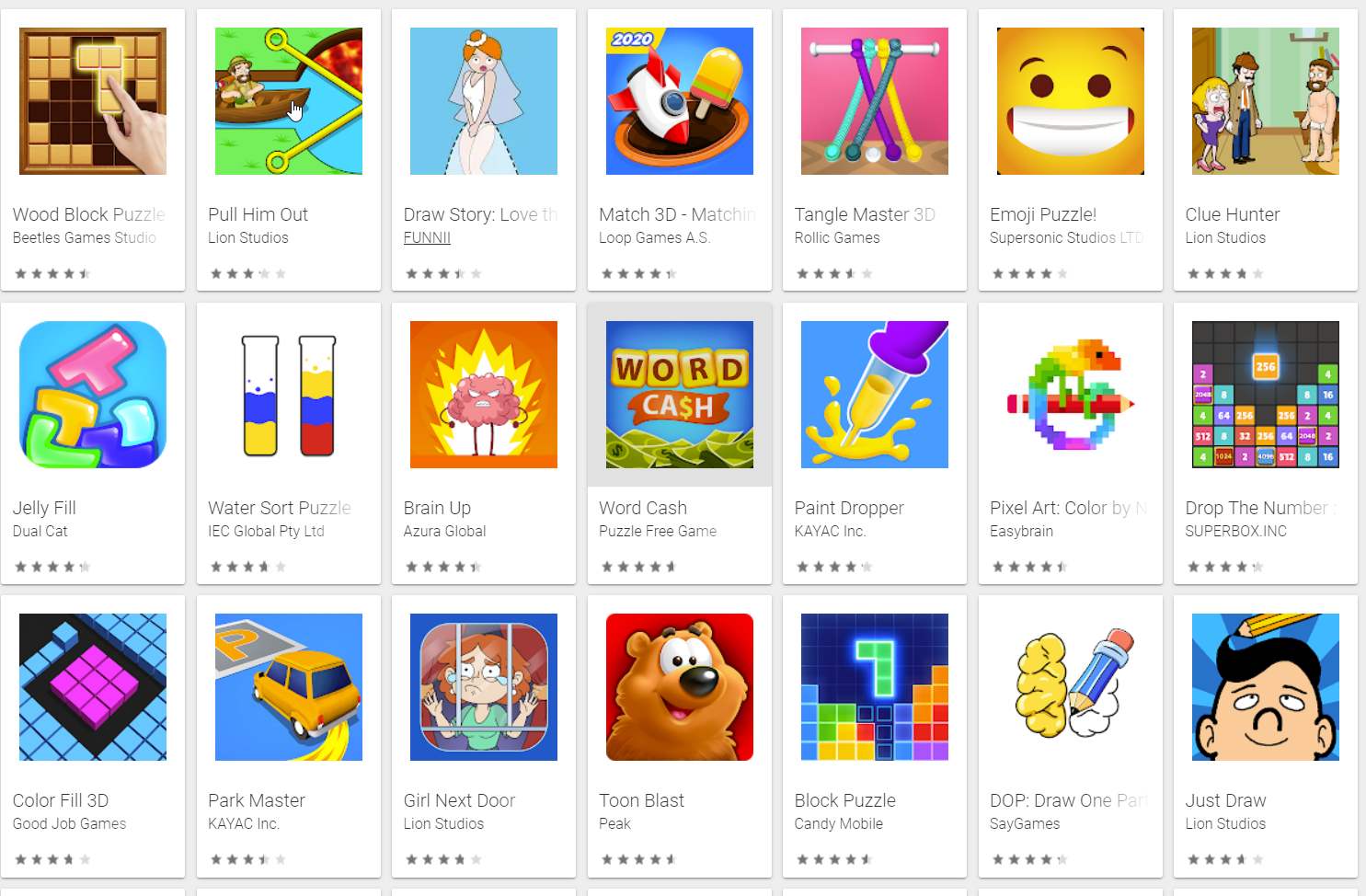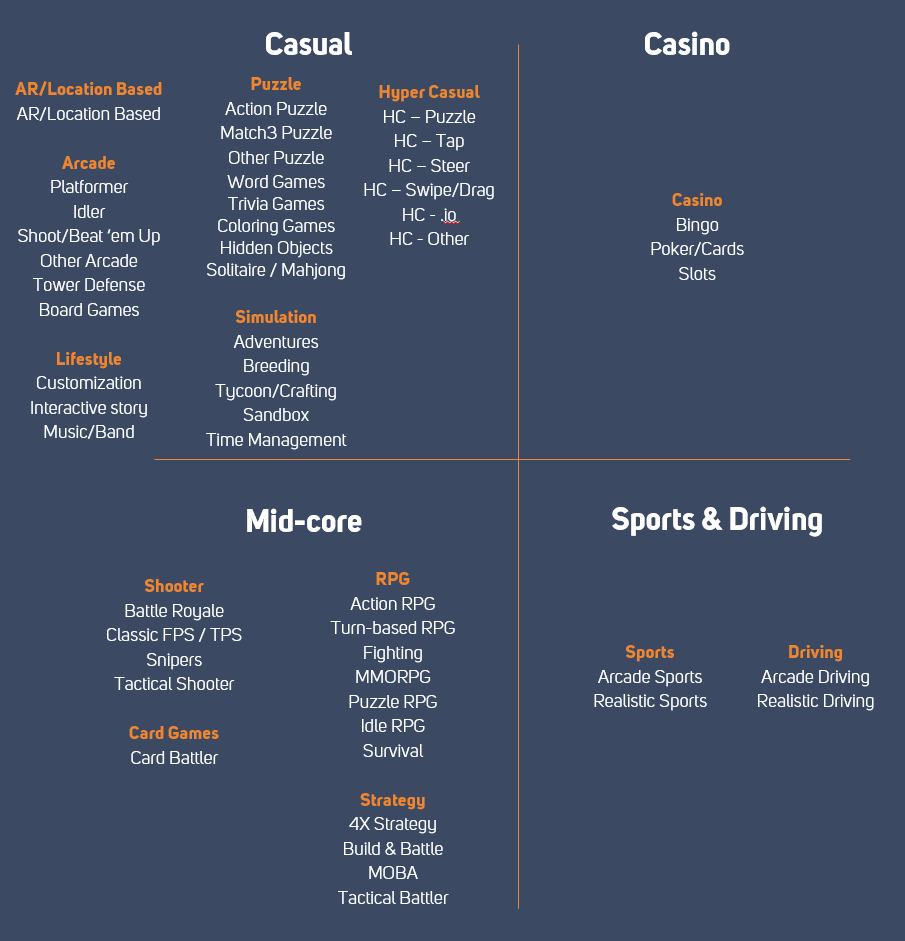
Why a new game classification in the app stores is in order

In 1997 we were introduced to ‘Snake’: a simple, intuitive, and addictive mobile game. It didn’t have ads or in-app purchases, and there were no game loops or incentives.
So much has happened since — the smartphone was born and the rest is history. In the early 2010s the free-to-play (F2P) or Freemium model was introduced, attracting new users and developers in massive numbers.
What quickly followed was that a huge variety of apps had surfaced to match user preferences. Mobile games were differentiated by things like game design, complexity, difficulty, monetization strategy, game plot, and so on.
It wasn’t long before the app stores divided mobile games into genres and sub-genres, and so we ended up with Casual games (including Board, Card, Puzzle, etc.), Hardcore & Midcore games (including Simulation, Action, Strategy, Role Playing, etc.), and Social Casino games.
Each genre and sub-genre was characterized differently and suitable for a different target audience.

During the last decade, the mobile gaming industry has enjoyed exponential growth in the number of actual players installing, exploring, playing, and most importantly knowing what the industry has to offer, and shaping their own preferences accordingly. Much of this surge was driven by the covid-19 pandemic when the numbers of new gamers surged.
In fact, according to Newzoo, mobile game revenues make up 50% of the global gaming market with over $92 billion generated in 2022.
To keep up with the massive player appetite, mobile game developers were quick to react, rapidly creating new games, and innovating to create new types of games.
In 2022, there were a staggering 1.2 million mobile games in the App Store and Google Play alone.
The current reality and why an update is needed
For most games, the only common factor these days is their app store category.
For example, if you browse through the Puzzle category in Google Play, this is what you’ll see:

Clearly, if you drill down further you’ll notice games that are very different from one another — in game mechanics, complexity, monetization models, features, etc.
There are significant drawbacks to this reality, namely:
- App store discovery is far less effective for users.
- Targeting similar players by app store classification is inaccurate and prevents marketers from reaching the potential of their user acquisition campaigns.
- Competitive analysis becomes far less effective as it isn’t based on an apples to apples comparison.
With such growth and variety of games, and in light of the above challenges, it is no wonder that the boundaries between the different gaming genres are constantly changing, and that developers are combining properties of different genres in their game.
Current store categorization classifies games such as Candy Crush Saga, My Talking Tom, Coin Master, and Homescapes under the same category (Casual). But these games have completely different game mechanics, different monetization, and a different target audience (my 3 year-old loves My Talking Tom, but won’t build a village in Coin Master or even play Candy Crush).
Another example can be found within Strategy games, where you’ll find Clash of Clans (in Google Play) — a game that requires players to invest time and money in building their village and clan, and includes multiple layers of complexity and strategic decision-making; but it also includes Cooking Frenzy — a game that allows you to cook and serve different dishes and earn rewards for your virtual cooking abilities.
There’s no doubt that these are great and highly successful games, but they have nothing in common. Grouping them under the same category in the app store is misleading for end-users and marketers who target Strategy games.
Last but not least, there are Hyper Casual games. It is very much different from its current Casual games categorization (sometimes you can even find these games under genres like Action, Puzzle, Racing, etc.). Hyper Casual games have completely different mechanics, features and complexity and deserve their own category in the stores.
Even in our own AppsFlyer reports, we had to change the app store classification to align with what game developers were looking for.
We decided to define Hyper Casual as gaming apps with the vast majority of their revenue coming from ads.
The road to relevance and accurate taxonomy
Realizing the shortcomings of the current classification, more and more gaming apps decided to manage their own taxonomy or use 3rd party providers that have created their own categorization logic to meet demand from gaming developers.
Different companies use different methodologies, definitions, and criteria when classifying games into genres and sub-genres, and also provide their own analytics dashboards to use their data to make better decisions. By doing so, they push the gaming ecosystem to the next level, where the in-game characteristic defines the game and the segment it belongs to.
For example, let’s explore the popular Match3 game (currently divided in the app stores between Casual and Puzzle) and what GameRefinery included in its taxonomy. A standard game has its own sub-genre under Casual games, but if a Match3 game also has character development features, it will be labeled as Puzzle RPG, giving it another dimension and far better relevance in discovery.
Another example from GameRefinery is Arcade games, a popular category in the app store, with a blurred definition.
In the app stores, we’ll see games such as Subway Surfers, Temple Run, Jetpack Joyride, and Sonic Dash. These games might define themselves in the app store as Arcade, but in fact attract a different type of users.

As mentioned earlier, different companies will do this differently but with a similar goal in mind.
For example, data.ai introduced its own take on gaming categorization. The company leveraged AI tools to create and maintain an automatic taxonomy tool, examining in-game characteristics to provide a granular definition of gaming categories.
This taxonomy focuses on three main categories; casual, core, and casino, broken into dozens of sub and sub-sub categories, divided by very specific game mechanics. And so we’ll see sub-sub categories such as breed-battle, card-battle, and summon battle (under core > strategy), and stunt racing, kart racing, or combat racing (under casual > racing).
This emphasizes that categorization is ultimately subjective and can be done differently with various levels of granularity.

Granularity is the name of the game
As the examples above illustrate, new game classification is not only about reshuffling the existing deck, but rather adding more cards for deeper granularity. Mobile gaming is so big, it demands it.
Why is granularity important?
- For developers: Whether you’re planning to penetrate a specific genre, or you already have a live game running, knowing your current and future competitors is key to success. By exploring games with similar functionality (feature-set, design, benchmarks, etc.) you can have a better understanding of what you’re up against, and act accordingly by changing strategies, adding/removing features, exploring launches in new markets, etc.
- For marketers: You invest many resources into digesting data and using it to make decisions that will eventually help you hit your performance targets. Using granular categorization will give you an additional layer when targeting relevant users that play games that are [truly] similar to yours, and there is a better chance that they will install your game after seeing your ad (improving IPM). This is a key tool for marketers to allow them to invest their budgets where it counts.
- For users: There are over 2.6 billion players globally, many of whom obviously like different games, with a different design, features, complexity, storyline, and so on. Players who explore new games can do it by engaging with ads they see for the games they already play, or use the app stores to find their next favorite game.
Granular categorization will certainly make life easier on end-users who want to play a game that fits their preferences instead of wasting their time installing and uninstalling games that are not a good fit (furthermore if this happens often, there is a risk that they will just ignore ads or refrain from app store discovery).
A recent Facebook report found that 49% of players are influenced by the game genre when trying a new game (image below) – the highest of all factors.
This emphasizes just how important granular and relevant genre classification is, and the impact it has on user experience and player decisions.
A final word on the need for standardization
The importance and necessity of relevant and granular game categorization is clear. It would only make sense to expect this to come directly from the app stores, providing gaming developers and marketers with a single source of truth.
Let’s admit it, organic discovery in gaming is becoming harder and harder for users, making organic growth a huge challenge for gaming app marketers. With the current store categorization, finding a game that truly matches your preferences and would keep you playing longer is not an easy task.
The App Store and Google Play should adapt to the new reality and give users, developers, and marketers what they need to succeed.





